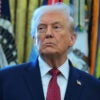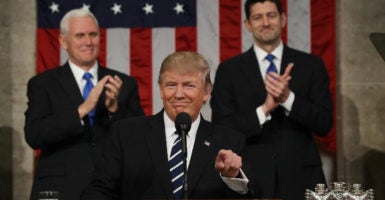On Tuesday, President Donald Trump delivered his first prime-time speech to a joint session of Congress. Heritage Foundation experts weighed in to respond to the president’s remarks on several policy fronts. Here’s what they had to say.
Economy
Welcome Commitment to Tax Reform
The president’s commitment to tax reform is welcome. Tax reform holds the promise of dramatically improving the incomes of working Americans and restoring prosperity.
Tax reform should reduce tax rates and reduce the double taxation of investment to improve the incentives to work, save, and invest. We have the highest corporate tax in the industrialized world. It must be reduced to make American businesses competitive and to create jobs. We must reduce the complexity of the tax system to reduce the burden on small businesses that create most new jobs.
– David Burton, senior fellow, economic policy
Reducing the Debt Is Key, but Details Are Few
Tonight, the president pledged to invest up to $1 trillion in the nation’s crumbling infrastructure, increase funding by $54 billion to begin rebuilding our national defense, and to increase spending for veterans, among other priorities. He also mentioned that under the Obama administration, the national debt had increased by almost as much as all of the previous administrations combined.
The question remains, how will these proposals be paid for and what will be done to begin paying down the debt? President Donald Trump provided no additional details as to how he would do so.
We have already learned that the increases to defense spending will be offset through much-needed reductions in the size and scope of other discretionary programs. These cuts will not only streamline the bloated federal bureaucracy, but also empower the private sector and local jurisdictions and help to stimulate innovation and economic growth.
However, it is unclear how investments in infrastructure and other priorities would be financed. It is crucial that any budget proposal put forth by the president in the coming weeks more than offsets any increases in spending and begins to put the national debt on a downward trajectory.
- Justin Bogie, senior policy analyst, fiscal affairs
An Incomplete Picture of Free Trade and Its Benefits
Trump spent a significant amount of time in his address discussing trade. For example, according to the president, “For too long, we’ve watched our middle class shrink as we’ve exported our jobs and wealth to foreign countries.”
He also proclaimed himself to be for free trade.
Trade is rightly an important issue to Trump. After all, trade is critical to America’s economy and the standard of living enjoyed by all Americans, and there are areas of trade policy that need to be improved. But to ensure that those reforms benefit Americans, we need to all be operating from the same set of facts.
Imports are good for American jobs. For years, Americans have been importing jobs and wealth from other countries. According to the Bureau of Economic Analysis, 6.6 million Americans work for foreign-owned companies in the United States. And since 2000, the United States has a manufacturing investment surplus of over $600 billion resulting from foreign companies using the dollars they earn from exporting to the United States to invest and create jobs here.
Trump added, “We’ve lost more than one-fourth of our manufacturing jobs since NAFTA was approved, and we’ve lost 60,000 factories since China joined the World Trade Organization in 2001.”
Here’s the rest of the story: U.S. manufacturing output is up 80 percent since NAFTA was approved, and it’s up nearly 50 percent since China joined the World Trade Organization.
Imports already face federal tariffs and state sales taxes. Trump also said: “Currently, when we ship products out of America, many other countries make us pay very high tariffs and taxes—but when foreign companies ship their products into America, we charge them almost nothing.”
There are plenty of tariffs and taxes to go around, and we should be working to reduce both.
The fact is that there are plenty of tariffs and taxes to go around, and we should be working to reduce both.
According to the Tax Foundation, imports are subject to state and local sales taxes of up to 9.46 percent. That’s on top of federal import taxes as high as 25 percent for pickup trucks and an average 13 percent tax on imported shoes and clothing.
Economic freedom is the answer. Finally, Trump announced a $1 trillion investment plan that he said “will be guided by two core principles: Buy American, and hire American.”
The president is correct to want to buy American and hire American. But it should not be a matter of policy to do so. Rather, the president, working with Congress, should help to ensure that American labor and products are the most competitive in the world by reducing taxes, reducing the regulatory burden, and ensuring that labor markets operate smoothly.
The better core principle for government purchases is to “buy the best products at the best prices.” That results in the best deal for taxpayers, less government borrowing from countries like China to finance excessive deficit spending, and fewer foreign “don’t buy American” laws that penalize U.S. firms doing business in other countries. And with policies that get out of the way of American businesses to succeed, there will be plenty of Americans being hired and American products being bought.
As The Heritage Foundation’s annual Index of Economic Freedom shows, countries that have the most economic freedom are the most prosperous. The best way Trump can help Americans is by boosting our economic freedom.
– Bryan Riley, Jay Van Andel senior analyst in trade policy
Trump Stays Focused on Repealing and Replacing Obamacare, With Better Options for All
In his remarks on Obamacare and health reform, Trump offered a basic framework of principles and objectives, but did not venture into details. That was the appropriate tack for him to take. As a rule, presidential speeches are better suited to challenging Congress and the country to accomplish broad policy goals, while leaving the details of achieving those goals to be worked out through the legislative process.
Trump kept the focus on the goal of repealing and replacing Obamacare. Now, Congress should take the first step to do that by repealing as much of the failing law as they can through the budget reconciliation process. They did that with the 2015 reconciliation bill and, now that they have a president who will sign such a bill, they can make that first step a reality. Only after they do that will they then be able to build consensus around the second step of enacting a set of alternative health reforms.
Repealing Obamacare is just the first step, and consists of no longer traveling in the wrong direction.
In essence, it is necessary to first take Obamacare “off the table” in order to create an opening for more constructive, thoughtful drafting of new legislation that moves health reform along the alternative trajectory of market-based, patient-centered reforms. Moving health reform in a different direction will, and should be, a longer-term process. Repealing Obamacare is just the first step, and consists of no longer traveling in the wrong direction. The second step of heading off in the right direction is a longer process.
Trump laid out the right vision when he said “we should help Americans purchase their own coverage—but it must be the plan they want, not the plan forced on them by our government.” That’s what presidential speeches are supposed to do.
– Ed Haislmaier, senior research fellow, health policy
Obamacare Repeal Process is an Opportunity to Defend Life
Trump’s call for repealing Obamacare is an opportunity to advance the cause of life. Congress is currently working to repeal Obamacare through the budget reconciliation process, which was used to send Obamacare repeal to President Barack Obama’s desk.
That 2015 bill serving as a model for the current effort made Planned Parenthood affiliates ineligible from receiving Medicaid reimbursements for one year after the enactment of the bill. Such federal reimbursements constitute a significant portion of the roughly $500 million in government funds sent to the nation’s largest abortion provider each year. Importantly, even if Planned Parenthood is denied certain federal funds, these dollars could still flow to the many other qualified health care providers that offer similar services as Planned Parenthood affiliates, plus additional services, without entanglement in elective abortion.
Repealing Obamacare is critically important to protecting life because the law opened new avenues for federal funding of abortion coverage by allowing health insurers that sell plans on many state exchanges to cover abortion while remaining eligible for federal subsidies in the form of an “affordability tax credit” available to low-income and middle-income Americans.
Obamacare requires nearly all health insurance plans to cover abortion-inducing drugs.
Some Americans who would otherwise object to paying for abortion coverage might sign up for a plan that includes elective abortion without their knowledge. Finding out whether or not a plan includes abortion coverage is a difficult endeavor, and insurers don’t have to disclose the existence and amount of the abortion surcharge until the time of enrollment (which may constitute a single sentence on a massive plan document).
Furthermore, Obamacare requires nearly all health insurance plans to cover abortion-inducing drugs.
Repealing Obamacare should be a smooth and methodical process that ultimately leads to a patient-centered, marked-based system that affords consumers more, not fewer, life-affirming options.
– Melanie Israel, research associate, DeVos Center for Religion and Civil Society
The Trump Presidency Is Officially Underway
Last night, the Trump presidency truly began. Here is why.
- Congressional Republicans who had been waiting were given their marching orders by their commander-in-chief. You will see stepped up action on a wide variety of issues from jobs to immigration in the weeks to come.
- The 63 million Trump voters were reassured by the president that he will fulfill his campaign promises.
- Democrats did not boycott the president, but showed up and even sometimes applauded him.
- Independents were encouraged by the bipartisan tone of the president and will support him increasingly.
- It has been said that President Ronald Reagan, the “Great Communicator,” could recite a shopping list and hold an audience’s attention. Last night, Trump held his audience in his hand for an hour while detailing his plans to create a new American spirit.
Summing up, the president was masterful—in a word, Reaganesque.
Lee Edwards, distinguished fellow, conservative thought
Immigration
Border Enforcement, Careful Vetting, and Immigration That Serves the Interests of Americans
In his first address to Congress, Trump reiterated that he intended to keep his promises on immigration, from building a wall to securing our southern border to finally enforcing our immigration laws and removing illegal aliens—“the bad ones”—who endanger our country. As he said, “we’ve defended the borders of other nations, while leaving our own borders wide open, for anyone to cross—and for drugs to pour in at a now unprecedented rate.”
In fact, he said that dangerous illegal immigrants were being removed as he was speaking to Congress. Enforcement of our immigration laws “will raise wages, help the unemployed, save billions of dollars, and make our communities safer for everyone. We want all Americans to succeed—but that can’t happen in an environment of lawless chaos. We must restore integrity and the rule of law to our borders.”
Trump issued a direct challenge to his audience of representatives and senators—“To any in Congress who do not believe we should enforce our laws, I would ask you this question: What would you say to the American family that loses their jobs, their income, or a loved one, because America refused to uphold its laws and defend its borders?”
Trump was clearly undeterred by the litigation filed against his executive order temporarily restricting visas to individuals from the seven terrorist havens in the Middle East. Trump made it clear that he would take action to ensure that terrorists do not enter our country, referencing information from the U.S. Justice Department that the majority of terrorist attacks in this country since 9/11 have been carried out by individuals who came here from elsewhere.
The president insisted that we should not allow entry of anyone who we cannot vet, saying that he will not allow our nation to become a sanctuary for extremists: “It is not compassionate, but reckless, to allow uncontrolled entry from places where proper vetting cannot occur. Those given the high honor of admission to the United State should support this country and love its people and its values.”
Finally, Trump proposed reforming our legal immigration system to protect “our workers” by switching to merit-based immigration, similar to countries such as Australia and Canada. The current system we have “depresses wages for our poorest workers, and puts great pressure on taxpayers.” It should be a basic principle of our immigration system that immigrants are able to “support themselves financially.”
Yet in America, according to Trump, “we do not enforce this rule, straining the very public resources that our poorest citizens rely upon.” Changing to a merit-based immigration system from our “current system of lower-skilled immigration” will “save countless dollars, raise workers’ wages, and help struggling families—including immigrant families—enter the middle class.”
Trump said that any reform of our legal immigration process must meet three principles: improve jobs and wages for Americans, strengthen our nation’s security, and restore respect for our laws.
Trump concluded the portion of his speech on immigration—an extremely contentious issue that has caused great debate in Congress—by saying that if “we are guided by the well-being of American citizens,” then “Republicans and Democrats can work together to achieve an outcome that has eluded our country for decades.” He is right.
– Hans von Spakovsky, senior legal fellow, Edwin Meese III Center for Legal and Judicial Studies
A Call to Reduce Low-Skilled Immigration
Trump called for reforming the legal immigration system to reduce the number of lower-skilled immigrants entering the U.S. The president stated that lower-skilled immigrants create a fiscal burden on U.S. taxpayers, receiving far more in benefits than they pay in taxes. He is correct.
The president is wise in calling for a reduction in financially draining low skill immigration.
According to figures calculated by the National Academy of Sciences, the average lower-skilled immigrant creates a negative fiscal balance of $400,000. This means over his lifetime, he will receive nearly $400,000 more in benefits than he pays in taxes. U.S. taxpayers must fund the difference.
On average, 472,000 adults with no more than a high school education immigrate to the United States every year. Under the present system, nearly 5 million lower-skilled immigrants can be expected to enter the U.S. over the next decade.
According to the National Academy of Science figures, these 5 million lower-skilled immigrants will impose a net cost (benefits received minus taxes paid) of $1.75 trillion on U.S. taxpayer over their lifetimes. The U.S. taxpayer cannot afford this added burden. The president is wise in calling for a reduction in financially draining low-skill immigration.
– Robert Rector, senior research fellow, domestic policy
Foreign Policy and National Security
A Strong Commitment to NATO
Trump in his remarks reiterated U.S. support for the NATO alliance and America’s commitment to collective defense. Trump’s statement of U.S. support for NATO is a clear message that will be received by friend and foe alike. This important message was communicated as well by Vice President Mike Pence and Defense Secretary James Mattis on their recent visits to Europe.
As Trump highlighted, NATO is the very bedrock of a trans-Atlantic security. A peaceful, stable Europe has led to economic, cultural, and military dividends that have and continue to serve U.S. national interests. Many of our closest friends and allies reside there. The U.S. is right to continue to play an active leadership role within NATO.
The U.S. is right to continue to play an active leadership role within NATO.
The president also once again highlighted that many of our NATO partners are not living up to their treaty obligations to spend adequately on defense. Weak defense spending by European NATO members threatens to undermine the collective security guarantee and play into the hands of adversaries, namely Vladimir Putin’s Russia.
The president is correct to press our allies on defense spending as successive U.S. leaders before him have. The U.S. should encourage European NATO members to put in place concrete timelines for attaining the agreed upon spending benchmarks. Reversing U.S. defense cuts, as Trump has expressed his intentions to do, will help the U.S. lead by example on defense spending.
– Daniel Kochis, policy analyst, European affairs
Strong Message of Support for National Defense
Tonight, Trump pledged that the military will get “the resources its brave warriors deserve,” promising that “if we fight, we win.” Trump went on to say that he will submit a “budget that will rebuild the military and eliminate the sequester.”
This support is sorely needed. Over the course of the last six years, defense funding has gone down 24 percent in constant dollars. The military is smaller than it has been in the last 50 years. It will take years of sustained funding and support to make this rebuilding a reality, but this president is signaling it will be a national priority. That’s welcome news.
– Thomas Spoehr, leutenant general, U.S. Army (retired); director, Center for National Defense
Legal
A Golden Pick for the Supreme Court
Tonight, Trump reminded Americans that he fulfilled his promise to pick a constitutionalist judge from his list of 21 candidates. With his nomination of 10th Circuit Judge Neil Gorsuch, he has chosen, as the president said tonight, “a man of incredible skill, and deep devotion to the law.” Gorsuch has a strong record that demonstrates his fidelity to the Constitution and his willingness to put the law as written above his own political views or policy preferences.
From his decisions on administrative law to religious liberty, Gorsuch leaves his personal views at home. During his confirmation hearings to the 10th Circuit, Gorsuch said that each case deserves the “complete attention of the judge without being diverted by personal politics, policy preferences, or what you ate for breakfast.” He later reiterated that he would “follow the law as written and not replace it with [his] own preferences, or anyone else’s.”
From his decisions on administrative law to religious liberty, Gorsuch leaves his personal views at home.
Trump also asked the Senate to “swiftly approve his nomination.” Senate Majority Leader Mitch McConnell has stated that he hopes to confirm Gorsuch by April 10, in time for the Supreme Court’s April sitting, which begins on April 17. This would allow Gorsuch to hear the remaining cases from this term, including an important religious liberty case that will decide whether states can exclude churches from secular grant programs solely because they churches.
– Tiffany Bates, research associate, Edwin Meese III Center for Legal and Judicial Studies
Restoring Law and Order to America’s Cities
Trump spoke eloquently tonight about the need for our country to “break the cycle of violence” in order to break the cycle of poverty, stating that he has directed the Department of Justice to form a task force on the issue. He noted that in 2015, there was a dramatic spike in the murder rate, the single largest increase in nearly half a century. This vicious cycle of violence has only continued to grow since then.
While violent crime rates are still well below their historic highs, that is not the case in some cities including Chicago, Baltimore, Milwaukee, and Memphis, where murder rates have returned to where they were in the 1990’s. In short, there is blood in the streets, and the president is determined to do something about it, emphasizing that this level of violence “is not acceptable in our society.”
The president also reminded us that our brave law enforcement officers must not only be part of the solution, they deserve our support because they are also “members of our community. They are friends and neighbors, they are mothers and fathers, sons and daughters—and they leave behind loved ones every day who worry whether or not they’ll come home safe and sound.”
And the president spoke about the pressing need to support the victims of crime, announcing that he has ordered the Department of Homeland Security to create an office called VOICE—Victims of Immigration Crime Engagement.
While crime rates are still well off from their historic highs, the trends are alarming and many members of the public, especially in our inner cities, certainly do not feel safe. Combatting this problem will be one of the president’s greatest challenges, and his success will have much to do with establishing his legacy.
– John G. Malcolm, director, Edwin Meese III Center for Legal and Judicial Studies
Infrastructure
No Specifics on Infrastructure, but Reforms Can Pave the Way
Although Trump’s speech did not yield many hard details, it’s clear that enacting a “new program of national rebuilding” to fix the nation’s “crumbling” roads, bridges, tunnels, airports, and railways continues to be a priority for him. (It must be noted that federal data show that the real state of highways and bridges is solid and is improving).
The president emphasized that the $1 trillion he intends to sink into infrastructure will come from both private and public sources. It’s encouraging that the president includes private capital, and he can do a great deal to make public investment much more effective through reform. But these improvements won’t come from simply dumping more federal dollars (or, to a lesser extent, tax expenditures) into “shovel ready” projects, which will not fix much of anything and will only help to break the bank. Spending won’t do much to create jobs either.
Instead of pledging to spend, the president should embrace strategic reforms that will refine the federal role in infrastructure and allow free-market principles—not the federal government—to guide infrastructure investment.
This agenda would make expenditures much more efficient on the public side—by giving states greater spending responsibility and negating cost-inflating regulations such as Davis-Bacon—and drive high levels of investment to public-use infrastructure by allowing users to fund roads and airports. Further reducing regulation would make it much more attractive for private entities and localities to invest in the nation’s vital assets.
The president pledged a change from the ineffective, top-down policies of the Obama administration. When it comes to fixing the nation’s infrastructure, he can keep his promise by seizing the opportunity and taking a better road to restoring American infrastructure.
– Michael Sargent, research associate, transportation and infrastructure policy
Trump’s Message on Coal, Keystone Signals New Directions for Energy Policy
Trump highlighted his executive orders to clear the way for the construction of the Dakota Access and Keystone XL pipelines and “stopping a regulation that threatens the future and livelihoods of our great coal miners.” Though simple, the message is about more than just a few pipelines, but a new direction for energy policy that unleashes free enterprise and innovation in the sector while protecting the environment.
America has nearly five centuries’ worth of coal under its soil. The Obama administration promulgated a long list of regulations that hurt miners, make it extremely difficult to build new coal-fired power plants, and would prematurely decommission a number of existing plants that are providing cheap, clean electricity. Saving coal from burdensome regulations that are devoid of any meaningful environmental benefit will not just improve life for those coal miners, but for all Americans households and businesses because higher energy prices impact their livelihoods, too.
A number of regulations must be on the chopping block to free up energy producers. The Department of the Interior should rescind its prohibition on coal leasing of public land, and the Environmental Protection Agency should withdraw its climate change regulations (both the Clean Power Plan and the New Source Performance Standards) that would fail to produce any climate benefit.
– Nick Loris, Herbert and Joyce Morgan research fellow, energy and environmental policy
Education
A School Choice Agenda to Empower America’s Schoolchildren
“Education is the civil rights issue of our time,” observed Trump in his joint address to Congress, before he went on to urge Congress to advance school choice options.
Although the administration is limited in what policies it can pursue at the federal level to advance education choice, there are five items that should be at the top of the president’s (and Congress’) school choice to-do list:
1. Support reauthorization of the D.C. Opportunity Scholarship Program. The highly successful D.C. Opportunity Scholarship Program, which provides vouchers to low-income children to attend a private school of choice, is due for reauthorization. Under the Obama administration, this program, which increased graduation rates for participants by 21 percentage points, was under constant threat of defunding.
This program should not only be supported through reauthorization and full funding, but also be expanded to enable more children living in the District to participate.
2. Expand choice in the District of Columbia. The Trump administration, along with Congress, should also work to make education funding in the District of Columbia entirely student-centered and portable, making D.C. an all-choice district.
3. Explore education savings accounts for military-connected children. Trump, along with Congress, should explore creating more school choice options for military families, reconstituting existing funding to create education savings account options for students.
4. Establish education savings accounts for children attending Bureau of Indian Education schools. The Government Accountability Office reports that “student performance at [Bureau of Indian Education] schools has been consistently below that of public school students, including other Indian students attending public schools.”
Parents of students who attend these schools should be made eligible for education savings accounts to pay for private school tuition, online learning, special education services and therapies, curricula, textbooks, and a host of other education-related services, products, and providers.
5. Allow K–12 expenses to be 529-eligible. Across the country, states have led the way in expanding education choice options for families. Federal policymakers can support this momentum by allowing K–12 education costs to be classified as allowable expenditures under 529 plans for college savings.
– Lindsey Burke, director, Center for Education Policy
































